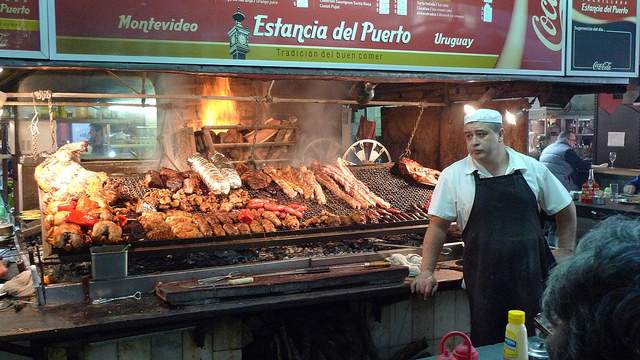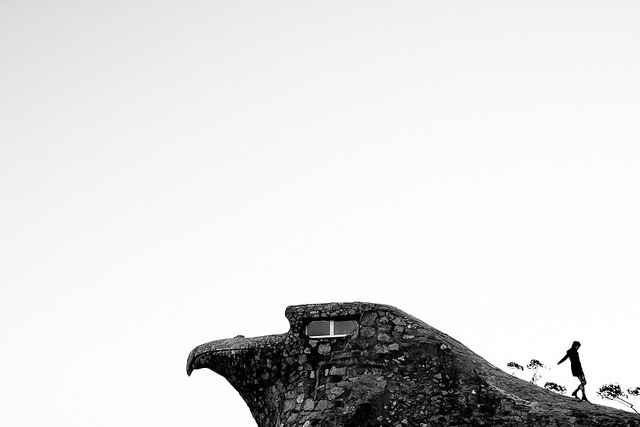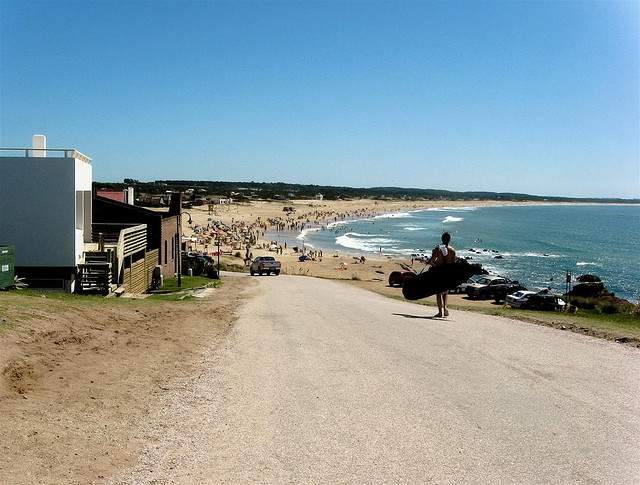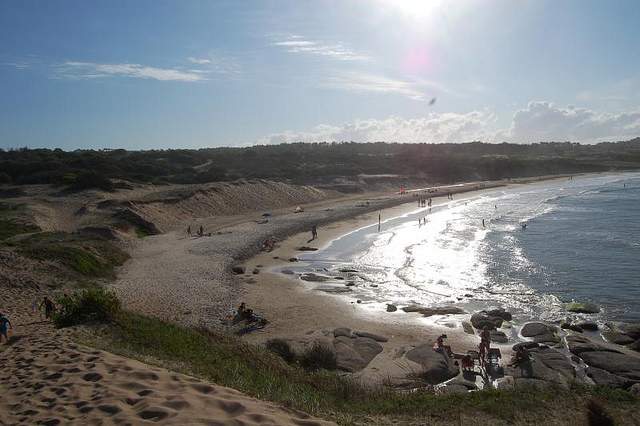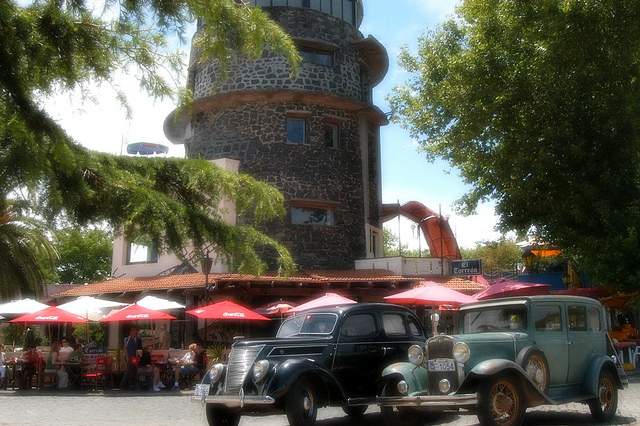Uruguay, the second smallest country in South America, is about the size of Washington State and snuggles between Argentina and Brazil. Its name, which originates from the Guarani language, means “river of the painted birds.” Each of Uruguay’s 19 sections, called departments, embellish the coastline like charms on a bracelet, possessing a unique personality, but somehow fitting in with whole. Rolling plains and fertile farmlands merge seamlessly into white sandy beaches and coastal fishing towns, and large, vibrant cities have pathways to the tranquil river. Uruguay pleases the historian, the cultural aficionado, and the antique or craft and art collector. Foodies and gourmands take delight with Uruguay’s hormone-free farming practices, rich local wines and organic vegetables. Outdoor enthusiasts enjoy surfing, fishing and para sailing.
Uruguay’s efficient bus system, which travels to even the most remote sections of the country, satisfies anyone concerned about their carbon footprint. Renting a car is unnecessary, since buses are inexpensive and reliable. In fact, in February 2011, Uruguayan President Mojica passed a law that fines buses for leaving more than five minutes past their scheduled departure time! The Uruguay bus system even has free wifi.
While Uruguay has some “big box hotels,” most are small, family run businesses, which include breakfast and Internet access in their room rates. Finding hotels or hostels with nightly rates under $50 is not impossible. Your flight to Uruguay is the most expensive part of the trip, but TAM Airlines, a Brazilian carrier, offers first class amenities, such as pre-flight drinks, snacks and amenity packs, even for those sitting in coach.
Uruguay’s stable economy and reputation as a peaceful and ethical country has gained the attention of ex-pat communities. So pack your bags, hop on a plane, and experience some of these highlight of Uruguay for yourself before the crowds arrive.
Meaty meals in Montevideo
Uruguayans elevate food grilling to an art form, and the Mercado Del Puerto, or Port market, is its theater. A huge structure adorned in cast iron houses this dynamic eating venue, where the cooks grill your food in front of your eyes. Meat is the star of the show in this country, which is famous for its healthy farming practices. Locals take an almost ritualistic approach to enjoying their meal. They begin with the sweet breads and follow with a plate of sausage. The rump is the grand finale. If you don’t eat red meat, the market is still worth a visit as the grilled chicken, fish and vegetables are equally delicious. Here’s an insiders tip. While table service is available, eating at the counter is cheaper, and more fun.
Over-eating at Puerto Del Mercato proves that you are only human, but no worries. You can burn off those extra calories at a tango class. Beginner tango lessons take place at Montevideo’s 1856 grand opera house, called Teatro Solis. Once you master the basics, visit the tango clubs in the Old City, and dance the night away.
Colonial architecture dominates Montevideo’s Old City, but luxury high-rises, overlooking the Rio de la Plata, populate the streets of the hip and trendy Pocitos. As you stroll along La Rambla, these waterfront buildings look the same until one edifice takes you by surprise. Castillo Pittamiglio, which sits between two high-rises, features a replica of the Victory of Samothrace, a statue commemorating an ancient Greek naval victory. The Louvre in Paris houses the original statue, but the replica adds serendipity to the Pocitos neighborhood. Humberto Pittamiglio, the owner and architect, built the castle in 1911. Alchemist, Templar, Masonic, and Rosicrucian symbols line its interior and a labyrinth of secret passageways create an intriguing tour for visitors. The labyrinths supposedly represent the transformational journey of the alchemist, but children enjoy the experience without understanding its philosophy.
>> Book a flight to Montevideo or read about being a vegetarian in South America
Architecture of Atlantida
Atlantida, located 40km from Montevideo on the 75-minute C4 bus, is both a beach town and a bedroom community for people who work in Montevideo. The beach is decidedly stunning, but there is more to Atlantida than scenic beaches.
A stone house, built in the shape of an eagle’s head with sea creatures and seaweed decorating its interior, immediately catches your eye. An Italian named Natalio Michelizzi built the house, called La Chimera, in the 1930s, as a private retreat. It is now a museum, open daily from 9 a.m to 6 p.m. The builder Michelizzi was not just a mystical hermit seeking privacy. This eccentric millionaire was quite the businessperson. He also built the huge Planeta Palace Hotel, shaped like a cruise ship and featuring a strange, Martian-like antenna on its roof. The hotel eventually evolved into an apartment building, but you can still visit the lobby. Inside, two art deco staircases dominate the lobby, while intricate relief abstracts embellish the ceiling.
The Chilean poet and political activist Pablo Neruda also spent time in Atlantida. Chile, a country that had a right-wing military takeover in 1973, frowned upon Neruda’s left-wing philosophies and Neruda’s current wife took issue with the poet’s amorous affair with the Chilean singer Matilde Urrutia. So the poet and chanteuse took refuse in a home in Atlantida, which is now a museum commemorating Neruda’s life and writings.
Those traveling with kids should visit the Estancia Turistica El Renacimiento, where guests can play gaucho for a day (or overnight), riding horses or horse-drawn carriages,or feeding the calves, ducks and geese. And if you are tempted to stay longer in Atlantida, but worry about your language skills, Spanish Uruguay offers affordable Spanish lessons. The company is also a travel agency, so they will find you a place to stay and arrange excursions to other towns.
>> Check out the best places in South America to spend the North American winter
Mysticism in Piriapolis
The coastal town of Piriapolis was Uruguay’s first beach resort. While the ritzy Punta Del Este now overshadows this simple town, some people find that an irresistible force draws them to Piriapolis. Perhaps its mystical history explains the appeal.
The town was founded by Francisco Piria, a scholar whose interests took him from studying with the Jesuit monks of Italy, to traditional Christianity, to the mystical doctrines of Kabbalah and alchemy. After returning to his homeland in Uruguay, a parcel of land in Cerro Pan de Azúcar, or Sugar Loaf, drew his attention. Freshwater springs, mineral-loaded mountains and fertile farmland characterized the area. Mining the granite from Sugar Loaf was his first order of business. He used the granite to establish a vineyard, a walnut grove and an olive orchard, and a new town, called Piriapolis, was born.
Designed in the style of Italian villas of the late 19th century, Piria’s 1897 home, called Piria’s Castle, which features statues of Greek gods lining the path (each one representing a planet and a metal used in alchemy) is now open to the public as a museum.
Those seeking further evidence of mystical Piriapolis will notice esoteric codes engraved into the architecture of the buildings. Piria allegedly hid the Tree of Life, from the Kabbalah, and the constellation of Aquarius in the layout of the streets of Piriapolis. If you prefer more active pursuits, enjoy a climb up Sugar Loaf Mountain or a surfing day at the beach. A chairlift ride up the Cerro San Antonio hill provides panoramic views of Piriapolis and nearby Punta Del Este.
Surfing and Spanish lessons in La Paloma
If California is Surfing USA, the Department of Rocha is Surfing Uruguay. Located in the eastern part of the country, the Department of Rocha encompasses towns including La Paloma, La Pedrera and Punta Del Diablo.
La Paloma has a Learn Spanish and Surf program, which offers Spanish lessons in the morning and surfing lessons in the afternoon. The all-inclusive program includes classes for all levels of Spanish and surfing proficiency. In between surfing and Spanish lessons, climb the 150 steps of the 1874 El Faro del Cabo Santa María Lighthouse or search for storks, black-necked swans and other waterfowl at the nearby Laguna del Rocha wildlife preserve. Visitors who come from July to October can also see Southern Right whales swimming very close to shore.
>> Learn about other places to learn to surf
The beach and the border in Punta Del Diablo
During peak season, the population in Punta del Diablo swells to over 20,000, but if you come outside of summer, you’ll find a small, sleepy seaside village. Unlike many of the town’s accommodation options, which are only open during the peak summer months, the El Diablo Tranquilo hostel is open all year round, allowing you to experience the town any way you like. This lively hostel offers guests an exciting menu of local activities, which include surfing lessons, Spanish lessons, tours of the area and horseback riding at Santa Tersesa National Park. The hostel also offers day trips to Karumbe, a marine turtle conservation center located 15 km from Punta del Diablo.
If you fall in love with El Diablo Tranquilo, you even have the option of working there from December to March. Workers receive a $200 monthly stipend, breakfast plus one other meal each day, lodging and basic health insurance.
When you feel like taking a side trip, head to the Brazilian border town of Chuy — one of the few places in Brazil that does not require a tourist visa. Its wide selection of duty-free shops, which specialize in discount electronics and computers, draws visitors to the area. One side of Chuy’s main boulevard is in Uruguay and the other side is in Brazil, an anomaly that inspires visitors to take photos that show them straddling two countries.
Crafts and culture in Colonia Del Sacramento
Serendipity is the best word to describe Colonia del Sacremento. Retro automobiles, dating as far back as the 1920s, park in front of well-preserved 17th century homes, while the local dogs peruse the cobblestone streets and offer their services as tour guides.
History buffs have a field day in Colonia Del Sacramento. This UNESCO site sits peacefully along the River Plate, and features a drawbridge and an ancient wall, both restored to their original condition. The town’s historic district is home to a number of small museums, including the Portuguese Museum, which displays 18th century weaponry and furniture; the Tile Museum, displaying 17th and 18th century tiles from France, Spain and Portugal; and the Indigenous Museum, home to a fascinating array of artifacts from the cultures who occupied Colonia 10,000 years prior to the arrival of European explorers.
Feria Artesanal, a market on Colonia’s northern waterfront, houses outdoor stalls and indoor shops where artisans sell handmade clothing, wool capes and sweaters, decorative notebooks, wall hangings and passport holders, and of course, mate tea and its traditional accompanying drinking vessel (a hollowed out gourd with a special metal straw). From Colonia you can also take the Buquebus, a 75-minute ferry ride to Buenos Aires. It’s worth a day trip if you are in the mood for some big city action.
>> Book a hostel in Colonia
The world’s longest Carnival
If life is a carnival, Uruguay is the big top. Its carnival season begins on the last week of January, and lasts until March. Every department has its own version of carnival, but the most dramatic event happens in Montevideo. There’s samba dancing in the streets, colorful parades and Muga, a group of men singing acappella songs that poke fun of current political issues. Drummers, dancers and partiers parade non-stop through the streets so forget about sleeping; there’s plenty of time for that when you get home.
Ready to go? Find flights to Uruguay, read our Uruguay travel guide, book an Uruguay adventure tour, or learn more about South America:
- Five Unexpected Treasures of South America
- Wine Tasting in South America: Where to Go and What to Try
- Experiences Not to Miss in Bolivia
- The Incredible National Parks of South America
Photos by: Henry0, jpcolasso, alexisbellido, drgmpd, PabloMFernandez, Vince Alongi, jikatu
